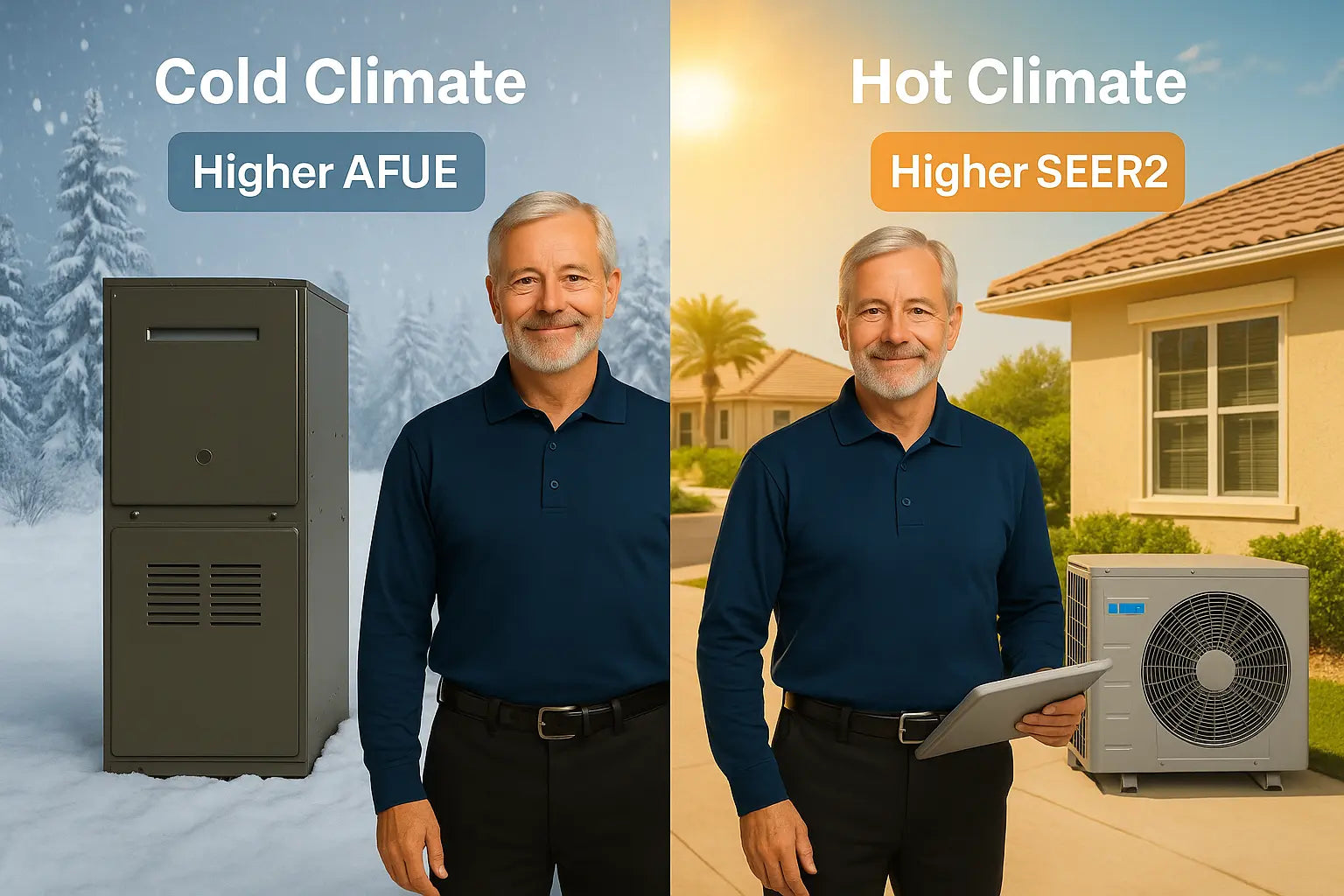Hi, I’m Alex Lane — your Home Comfort Advocate. I’ve spent 8 years in the HVAC field helping homeowners make smarter, safer, and more efficient choices for their comfort systems. One of the most overlooked factors I run into when helping folks size their heating and cooling? Their climate zone.
It’s easy to think HVAC sizing is just about square footage — but trust me, where you live changes everything. What works in Phoenix might fail in Chicago. In this guide, we’ll dig into why your climate zone matters, how it affects your system sizing, and how to avoid costly mistakes by choosing the right equipment for your environment.
Your local climate plays a huge role in how your HVAC system should be sized. A heat pump that works great in Georgia might be undersized in Minnesota — and vice versa for a furnace in Arizona. In this guide, we’ll break down how climate zones influence your HVAC sizing needs, how to determine your zone, and how to choose equipment that matches your environment and lifestyle.
What Is a Climate Zone?
How the U.S. Divides Heating and Cooling Needs
The U.S. Department of Energy (DOE) and the International Energy Conservation Code (IECC) divide the country into eight main climate zones, based on heating degree days, humidity levels, and typical seasonal temperatures.
There are three main categories:
-
Hot (humid, dry, and marine)
-
Mixed (humid or dry)
-
Cold/Very Cold/Subarctic
To see which zone you live in, check out the DOE Climate Zone Map.
These zones don’t just describe the weather — they directly impact how large or small your HVAC system should be, and what features will matter most.
Why Climate Matters in HVAC Sizing
Heating Load vs. Cooling Load
Climate zones help determine whether your home’s heating or cooling load is the dominant design factor. That affects:
-
BTU output per square foot
-
Equipment selection (furnace vs. heat pump)
-
SEER2 and AFUE efficiency priorities
For example:
-
Zone 2 (Hot-Humid): Prioritize cooling efficiency (SEER2), oversized ductwork for airflow, and humidity control.
-
Zone 6 (Cold): Focus on heating capacity (BTUs), system backup reliability, and insulation upgrades.
Your Manual J calculation (see our post: Manual J Calculation Explained) will also factor in your zone for accurate load sizing.
According to ENERGY STAR’s Heating and Cooling Guide, properly sized equipment based on climate can reduce energy bills by up to 20% while improving comfort.
How Climate Zones Affect HVAC System Selection
Tailoring Equipment Type and Features
Here’s how different climate zones influence system choice:
🔥 Hot-Humid Zones (e.g., Florida, Texas)
-
High cooling load, low heating demand
-
Ideal for high-SEER air conditioners or heat pumps
-
Look for systems with variable-speed blowers and dehumidification features
❄️ Cold and Very Cold Zones (e.g., Minnesota, New York)
-
Large heating load, modest cooling demand
-
Choose high-BTU furnaces or cold-climate-rated heat pumps
-
Dual-fuel systems work well to optimize electric/gas use
🌤 Mixed Zones (e.g., North Carolina, Kentucky)
-
Balanced heating and cooling loads
-
Focus on overall efficiency (SEER2 and AFUE)
-
Smart thermostats and zoning help maintain comfort year-round
Check ENERGY STAR’s Heat Pump Equipment and Central ACs Key Product Criteria for more tailored suggestions based on regional needs and performance standards.
According to the U.S. Department of Energy, climate-responsive HVAC equipment must meet specific regional standards designed to improve energy efficiency and performance — ultimately saving homeowners money and improving comfort.
Ductwork and Insulation Considerations by Zone
Why Supporting Components Matter Too
HVAC performance depends on more than just the unit:
-
Hot zones benefit from reflective roofing, radiant barriers, and air-sealed ductwork
-
Cold zones should prioritize attic insulation, wall R-values, and vapor barriers
-
Mixed zones need balanced ventilation and programmable thermostats
These improvements help your system work with your climate, not against it. You can learn more about energy-smart upgrades by visiting the Building America Solution Center.
Mistakes to Avoid When Sizing for Climate
-
Using generic BTU per square foot estimates
-
Ignoring local temperature extremes
-
Skipping insulation upgrades before sizing
-
Undersizing cooling in humid climates
-
Oversizing heating in mild winters
Always get a professional Manual J done for the most accurate results. And remember — don’t just replace your old unit with the same size. Your climate zone and home may have changed.
Don’t Forget the Full Picture: HVAC Sizing from A to Z
Sizing isn’t just about climate — it’s one part of a complete system evaluation. You’ll also need to consider:
-
Duct design (Manual D)
-
Equipment specs (Manual S)
-
Room-by-room airflow needs
If you're not sure where to start, explore our full guide: How to Size an HVAC System for Your Home. It covers every variable you should consider when planning your next HVAC upgrade.
Final Take: Climate-Responsive HVAC = Comfort + Savings
Whether you're battling humidity in the Southeast or sub-zero winters in the Midwest, your HVAC system should be designed for your climate. That’s the only way to ensure energy efficiency, equipment longevity, and year-round comfort.
Need a full breakdown of what goes into sizing an HVAC system? Check out our in-depth guide: How to Size an HVAC System for Your Home.
Climate isn’t the only factor that changes how you size your system — the type of equipment you choose matters too. Read next: Sizing a Heat Pump vs. a Furnace: What’s Different?
Alex Lane
Your Home Comfort Advocate







